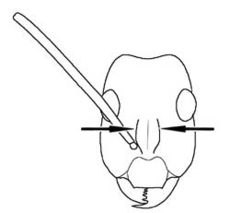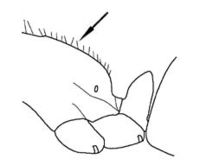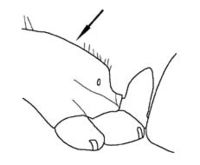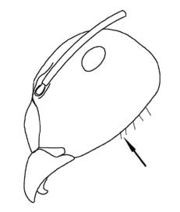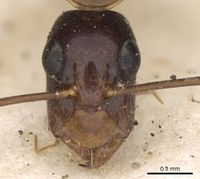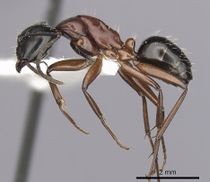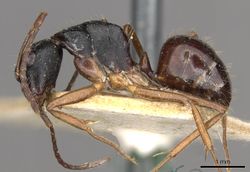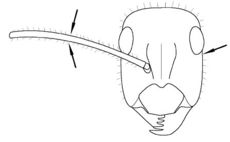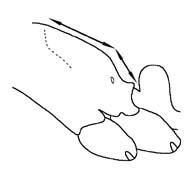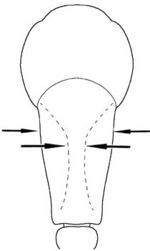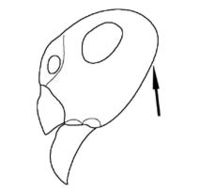Key to Australian Camponotus minors of the southwestern Botanical Province
This key to minor workers is based on: Heterick, B. E. 2009a. A guide to the ants of South-western Australia. Records of the Western Australian Museum, Supplement 76: 1-206. Part 1.
Since the publication of this key the genus Colobopsis has been removed from its synonymy with Camponotus. Colobopsis species are therefore included in this key.
There is also a key to majors.
You may also be interested in
1
- Inner surfaces of middle and hind tibiae lacking elongate setae (Figure 186a); frontal carinae width usually > 1/2 HW (slightly less than ½ HW in C. macrocephalus group sp. JDM 927) (Figure 250); (macrocephalus species-group) . . . . . 2
- Inner surfaces of middle and hind tibiae with double row of stout bristles (Figure 187); frontal carinae width <1/2 HW (Figure 251) . . . . . 3
2
return to couplet #1
- Mesosoma and node without erect setae or pubescence; venter of head capsule without erect setae; in profile, protuberances on dorsum of mesosoma smoothly rounded; propodeal spiracle near midpoint of propodeum (Figure 252) . . . . . Colobopsis gasseri
|}
- Mesosoma and node pubescent, erect setae on all body surface; a few erect setae on venter of head capsule; protuberances on dorsum of mesosoma rather angulate in outline; propodeal spiracle near declivitous face of propodeum (Figure 253) . . . . . Colobopsis macrocephala group sp. JDM 927
|}
3
return to couplet #1
- Mentum with elongate, J-shaped setae near its posterior margin (Figure 188) (C. wiederkehri species-group) . . . . . 4
- Without elongate J-shaped setae on posterior margin of mentum (Figure 189) . . . . . 15
4
return to couplet #3
- Head capsule strongly tapered posteriad, with fluted edges around foramen (Figure 254) . . . . . Camponotus johnclarki
- Head capsule rounded in normal way posteriorly (Figure 255) . . . . . 5
5
return to couplet #4
- Surfaces of tibiae and antennal scape with many erect, bristly setae (Figure 256a, b) . . . . . 6
- Surfaces of tibiae and antennal scape lacking erect, bristly setae (Figure 257a, b) . . . . . 7
6
return to couplet #5
- In profile, petiolar node thick, about as high as wide, pubescence on head and gaster abundant, individual setae overlapping (Figure 190b) . . . . . Camponotus gouldianus
- In profile, petiolar node thinner, about twice as high as wide; pubescence on gaster less abundant, individual setae usually not overlapping (Figure 191b) . . . . . Camponotus terebrans
7
return to couplet #5
- Metanotal groove strongly impressed, rising abruptly at commencement of propodeum (Figure 258a); petiolar node elongate, flattened, with anterior face much shorter than posterior face (Figure 258b) . . . . . Camponotus versicolor
- Metanotal groove, at most, only weakly to moderately impressed (e.g. Figures 259a, 260, 261), in such cases not rising abruptly with commencement of propodeum; petiolar node variable but not normally elongate and vertex often distinctly convex, its anterior face only slighter shorter than its posterior face (Figure 259b) . . . . . 8
8
return to couplet #7
- Angles of vertex acute; ant with 'hump-backed' appearance (Figure 192) . . . . . Camponotus postcornutus
- Angles of vertex rounded; dorsum of mesosoma gently to moderately sinuate (e.g. Figure 193) . . . . . 9
9
return to couplet #8
- Metanotal groove visibly impressed, propodeum distinctly convex (Figure 260); first gastral tergite may be lighter in colour than remaining tergites . . . . . 10
- Metanotal groove vestigial or absent, propodeal dorsum straight or barely convex (Figure 261); first gastral tergite concolorous with remaining tergites . . . . . 11
10
return to couplet #9
- In full-face view, setae on the lower sides of head capsule lacking; head and mesosoma red (Figure 262) . . . . . Camponotus wiederkehri group sp. JDM 924
- In full-face view, head capsule with many erect setae around its perimeter; head and mesosoma orange (Figure 263) . . . . . Camponotus wiederkehri group sp. JDM 925
11
return to couplet #9
- Eye larger, eye length about 1/4 length of head capsule (Figure 264) . . . . . Camponotus wiederkehri
- Eye smaller (eye length 1/5 ≤ head length) (Figure 265) (ants in C. ceriseipes complex) . . . . . 12
12
return to couplet #11
- Viewed from behind, appressed setulae on one side of gaster gradually converging towards centre of gaster, without clear central line of demarcation (Figure 266) . . . . . Camponotus ceriseipes complex sp. JDM 105
- Viewed from behind, appressed setulae on one half of gaster the mirror image of appressed setulae on the other half, the two sides meeting in a clear line of demarcation (most noticeable on tergites 2–4) (Figure 267) . . . . . 13
13
return to couplet #12
- Erect setae sparse on mesosoma, on propodeum 4 ≤, clustered on or near propodeal angle . . . . . Camponotus donnellani
- Erect setae abundant on mesosoma, on propodeum 4 >, arranged along length of Sclerite . . . . . 14
14
return to couplet #13
- Scapes relatively shorter (SI < 150); petiolar node often tending to rectangular in profile, rounded above and inclined anteriad . . . . . Camponotus ceriseipes
- Scapes relatively longer (SI > 150); petiolar node often tending to tumular in profile, rounded above and inclined anteriad . . . . . Camponotus prosseri
15
return to couplet #3
- Clypeus concave or with anteromedial notch; clypeus projecting beyond genae, clypeal angles acute or right-angled (C. nigriceps species-group) (Figure 200) . . . . . 16
- Conformation of clypeus not as above . . . . . 20
16
return to couplet #15
- Setae on venter of head capsule absent (Figure 201) . . . . . Camponotus longideclivis
- Setae on venter of head capsule present (Figure 202) . . . . . 17
17
return to couplet #16
- Dorsum of propodeum with > 10 erect setae, setae distributed over propodeum (Figure 203) . . . . . 18
- Dorsum of propodeum with < 10 erect setae at or near propodeal angle (Figure 204) . . . . . 19
18
return to couplet #17
- Head, mesosoma, node and most of gaster uniformly honey coloured . . . . . Camponotus clarior
- Head black or brown, mesosoma yellow or red-brown . . . . . Camponotus nigriceps
19
return to couplet #17
- Erect setae on venter of head capsule 20 >, or setae covering more than 1/2 venter area (Figure 205); typically, head dark brown or black, mesosoma yellowish to dark red and gaster brown or black, with or without yellowish colouration anteriad . . . . . Camponotus dryandrae
- Erect setae on venter of head capsule 20 <, or setae covering less than 1/2 venter area (Figure 206); typically, head, mesosoma and gaster concolorous dark brown or black . . . . . Camponotus prostans
20
return to couplet #15
- Head capsule behind eyes strongly attenuated, the edges of the foramen fluted or flanged (Figure 268a, b); number of mandibular teeth usually 7 or more (C. subnitidus species-complex) . . . . . 21
- Head capsule behind eyes not strongly attenuated, the edges of the foramen normal (Figure 269a, b); number of mandibular teeth often 5 or 6 . . . . . 22
21
return to couplet #20
- Setae on venter of head capsule absent; number of mandibular teeth 9, mesosoma reddish-brown . . . . . Camponotus rufus
- Setae on venter of head capsule present; number of mandibular teeth 7 or 8, mesosoma ochre to brown . . . . . Camponotus tricoloratus
22
return to couplet #20
- Body and appendages covered with short, white, erect setae; pubescence lacking on head, gaster and most of mesosoma; number of mandibular teeth 7; clypeus projecting, its anterior margin straight, without central notch or depression . . . . . Camponotus molossus
- Body and appendages rarely covered with short, white, erect setae; if many white, erect setae present, then differing in one or more of the other characters . . . . . 23
23
return to couplet #22
- Metanotal groove deeply impressed, the propodeum quadrate (Figure 270); sculpture of head and mesosoma densely microreticulate-foveate . . . . . Camponotus whitei
- Metanotal groove weakly impressed or obsolete, propodeum not quadrate . . . . . 24
24
return to couplet #23
- Combination of 9 or 10 mandibular teeth, gracile body and elongate head capsule that is moderately attenuated behind large compound eyes (Figure 271) . . . . . Camponotus claripes group sp. JDM 63
- Number of mandibular teeth usually 8 ≤; if 7 or more, then head capsule not as above, usually square, often with vertex broad and somewhat flattened . . . . . 25
25
return to couplet #24
- Propodeum with a transverse notch about midpoint of its dorsal face (Figure 272) . . . . . Camponotus sp. JDM 26
- Propodeum without transverse notch (Figure 273) . . . . . 26
26
return to couplet #25
- Number of mandibular teeth nearly always 7 or 8, very rarely 6 or 9 teeth on one or both mandibles (in which case mesosoma is distinctly concave in profile), mesosoma with concavity or angle at metanotal groove, or propodeum concave; head often square with eyes set at or near angles of vertex (Figures 274); body often densely hairy or with thick pubescence (C. ephippium species-complex) (Figure 275) . . . . . 27
- Number of mandibular teeth 5 or 6; in profile, dorsum of mesosoma often strongly convex, dorsum of propodeum may have a distinct concavity or 'saddle' in a few species, but usually convex or straight in outline; vertex of head capsule often strongly convex with eyes set well below vertex (taxa with flattened vertex or with angle between vertex and sides of head capsule usually have 5 teeth and a strongly convex propodeal dorsum in profile); body rarely with thick pubescence . . . . . 38
27
return to couplet #26
- In profile, vertex of head capsule tapered to a blunt angle; body with pinkish iridescence (appearance that of a meat ant (Iridomyrmex purpureus group)) (Figure 276) . . . . . Camponotus perjurus
- In profile, vertex of head capsule not tapered to a blunt angle, pinkish iridescence lacking, appearance not meat-ant like . . . . . 28
28
return to couplet #27
- Small species (HW ≤ 1 mm) . . . . . 29
- Species larger (HW ≥ 1.5 mm) . . . . . 30
29
return to couplet #28
- Non-gracile species; in full-face view, head capsule almost as wide as long; clypeus projecting forward, its anteromedial clypeal margin straight (Figure 277) . . . . . Camponotus sponsorum
- Gracile species; in full-face view head capsule less than two thirds as wide as long; anterior margin of clypeus strongly and evenly convex (Figure 278) . . . . . Camponotus longifacies
30
return to couplet #28
- Vertex convex, without distinct separation between vertex and sides of head capsule; eyes placed somewhat below level of dorsum of vertex (Figure 279) . . . . . 31
- Vertex flat or nearly so, vertex and sides of head capsule may be separated by angle; eyes placed at or near dorsum of vertex (Figure 280) . . . . . 33
31
return to couplet #30
- Tibiae (Figure 281a) and antennal scape (Figure 281b) (and rest of body) covered with many long, erect, white setae . . . . . Camponotus pawseyi
- Tibiae (Figure 282) and antennal scape (Figure 283), at least, lacking long, erect, white setae . . . . . 32
32
return to couplet #31
- Tibial setae raised to angle of about 20 degrees (Figure 284); in full-face view sides of head with very many erect, white setae; antennal scape often with several semi-erect setae . . . . . Camponotus cinereus notterae (in part - also #35)
- Tibial setae appressed or barely raised (Figure 285); in full-face view, sides of head with fewer (usually 12≤), erect, white setae; antennal scape lacking semi-erect setae . . . . . Camponotus ephippium complex sp. JDM 775
33
return to couplet #30
- Tibial setae raised to angle of 20 degrees, giving leg of ant a shaggy appearance (Figure 284) . . . . . 34
- Tibial setae appressed or barely raised (Figure 285) . . . . . 36
34
return to couplet #33
- With combination of vertex of head completely flattened, with blunt angle distinctly separating dorsum of head from its sides (Figure 280) and antennal scape with several longer, erect or semi-erect setae . . . . . Camponotus near ephippium sp. JDM 431
- Either vertex of head not so flattened, without distinct separation of dorsum and sides (Figure 279), or antennal scape lacking several longer, erect or semi-erect setae except at the end . . . . . 35
35
return to couplet #34
- In full-face view, vertex of head behind eyes slightly convex, narrowed towards occiput, eyes set just below posterior angles of vertex (Figure 286); sides of head with many erect setae; ant black or black-and-red in colour with orange mid and hind femora, femora black distally . . . . . Camponotus cinereus notterae (in part - also #32)
- In full-face view, vertex of head behind eyes flattened, truncated, not narrowed towards occiput, eyes set at posterior angles of vertex (Figure 287); sides of head usually with few erect setae; colour various but legs not as above . . . . . Camponotus ephippium
36
return to couplet #33
- Individual minute setulae comprising pubescence linked together in rows, giving feathery appearance to each cluster, thick and overlapping on clypeus (Figure 288) . . . . . Camponotus dromas
- Individual setulae comprising pubescence distinct, less abundant and non-overlapping on clypeus (Figure 289) . . . . . 37
37
return to couplet #36
- Appressed setae on body minute, sparse; those on gaster well-separated; nearly always black with red head (very rarely, head and mesosoma reddish-orange, gaster black, or ant entirely black) . . . . . Camponotus capito ebeninithorax (“black soma”)
- Appressed setae on body longer, more abundant; those on anterior of gastral tergites overlapping, forming whitish pubescence; colour variable, often red, or red and dark red, but not distinctly bicoloured as above . . . . . Camponotus capito ebeninithorax
38
return to couplet #26
- Very small (HW ≤ 1 mm); body very compact, in profile, pronotum slightly convex anteriorly, otherwise dorsum of mesosoma almost straight; in profile, propodeal angle produced as a broad, bluntly rounded shelf overhanging the node, declivitous face of the propodeum deeply concave (Figure 290); sculpture densely foveate; body and appendages orange to dark reddish-orange . . . . . Camponotus sp. JDM 695
- If appearance generally as above, in profile, propodeal angle not produced to form a blunt shelf overhanging a deeply impressed declivitous propodeal face . . . . . 39
39
return to couplet #38
- Gaster black with yellowish-green sheen, finely microreticulate, the cells even and impressed; cuticular membrane at apex of each tergite yellowish; head and mesosoma finely sculptured, black or black-and-red with faint white or yellowish sheen; propodeum long, barely to moderately concave (in latter case forming a 'saddle'); in rear view, sides of mesopleuron and propodeum not or barely compressed; legs red to dark reddish-brown (C. nigroaeneus complex, pt.) . . . . . 40
- Appearance of gaster not as above; otherwise often differing in one or more characters . . . . . 43
40
return to couplet #39
- Pronotum and mesonotum black, propodeum and posterior of metapleuron bright crimson . . . . . Camponotus chalceus
- Colour combination of mesosoma not as above . . . . . 41
41
return to couplet #40
- In profile, dorsum of propodeum moderately concave, the propodeal angle raised, forming a small hump . . . . . Camponotus nigroaeneus complex sp. JDM 1031
- In profile, dorsum of propodeum not or barely concave, the propodeal angle not raised . . . . . 42
42
return to couplet #41
- In full-face view, vertex of head slightly concave, sides of head moderately convex (Figure 291) . . . . . Camponotus hartogi
- In full-face view, vertex of head moderately convex, sides of head more-or-less straight (Figure 292) . . . . . Camponotus innexus
43
return to couplet #39
- Declivitous face of propodeum steep, long (ratio between length of dorsum of propodeum and its declivitous face much less than 1:1, often 1:2–1:3) (Figure 293); viewed from rear, sides of propodeum strongly laterally compressed and tapering to a blunt to sharp edge posteriad (Figure 294); sculpture of mesopleuron and propodeum consisting of evenly impressed microreticulation; body concolorous black or dark brown, legs often light in colour; number of mandibular teeth usually six, rarely five (e.g. in some specimens of C. tristis) . . . . . 44
- If declivitous face of propodeum steep and long, then propodeal sides not tapering to blunt or sharp edge or body colour not concolorous black (members of C. lownei complex, which are similar, always have five mandibular teeth, the propodeal flanks are less compressed; the mesopleural and propodeal microsculpture is superficial without uniform, impressed microreticulation, and the colour may be brown, reddish or bicoloured shades of brown or red-and-black) . . . . . 48
44
return to couplet #43
- Erect setae completely absent from dorsum of mesosoma . . . . . Camponotus oetkeri
- At least two pairs of erect setae present on mesosoma . . . . . 45
45
return to couplet #43
- Ant completely black, dull in appearance; propodeal angle not distinct . . . . . Camponotus tristis
- Ant with femora, at least, normally lighter coloured than the body (usually yellow or reddish), if femora dark, then ant with relatively sharp propodeal angle (rare C. michaelseni workers); usually shining in appearance . . . . . 46
46
return to couplet #45
- Dorsum of mesosoma with more than three pairs of erect setae (usually many); pronotum and mesonotum distinctly shagreenate in appearance . . . . . Camponotus oetkeri voltai
- Dorsum of mesosoma with 2 or 3 pairs of erect setae; sculpture on pronotum and mesonotum very weak, these sclerites shiny in appearance . . . . . 47
47
return to couplet #46
- Femora yellowish (rarely dark brown), tibiae brown; propodeal angle distinct (Figure 295) . . . . . Camponotus michaelseni . . . Camponotus tumidus
- Legs uniformly light brown to yellowish; propodeal angle indistinct (Figure 296) . . . . . Camponotus claripes
48
return to couplet #43
- Five mandibular teeth (basal (sixth) tooth may be represented by minute denticle or angle); in profile, pronotum flat, metanotal groove obsolete; propodeum usually steeply declivitous (Figure 297) . . . . . 49
- Six distinct mandibular teeth; profile usually different (e.g. Figure 298) . . . . . 58
49
return to couplet #48
- Head and at least pronotum and mesonotum of mesosoma densely foveate-punctate; matt in appearance, colour of body and appendages orange . . . . . 50
- Head and mesosoma usually shining, either smooth or with microsculpture; if matt in appearance and reddish, then sculpture finely shagreenate; most commonly black or dark brown with lighter appendages (C. lownei complex) or mottled or concolorous ochre (some populations of C. gibbinotus) . . . . . 51
50
return to couplet #49
- Head and mesosoma densely foveate-punctate (Figure 299); very many erect setae on body, femora and antennal scape; matt in appearance . . . . . Camponotus sp. JDM 771
- Sculpture and appearance generally as above, but dorsum and sides of propodeum with fine, parallel striolae rather than fovea or punctures (Figure 300); femora and antennal scape lacking erect setae, except at the ends . . . . . Camponotus sp. JDM 1038
51
return to couplet #49
- Propodeal angle absent or very weak, dorsum of propodeum rounding smoothly into declivitous surface of propodeum (Figure 301) . . . . . 52
- Propodeal angle present, dorsum and declivitous face of propodeum distinctly separate (Figure 302) . . . . . 54
52
return to couplet #51
- Uniformly pale ochraceous; basal (sixth tooth) may be represented by a minute half denticle or angle; seen from rear propodeum strongly laterally compressed with distinct edge . . . . . Camponotus gibbinotus (in part - also #75)
- Head much darker than mesosoma when ant viewed dorsally, or ant uniformly dark brownish or black; five mandibular teeth; seen from rear propodeum only moderately laterally compressed without distinct edge . . . . . 53
53
return to couplet #52
- When viewed full-face, head capsule rectangular, eyes placed well below vertex (Figure 303) . . . . . Camponotus discors complex sp. JDM 772
- When viewed full-face, head capsule square, eyes placed near vertex (Figure 304) . . . . . Camponotus lownei complex sp. JDM 616
54
return to couplet #51
- Head and gaster black, mesosoma, node and legs bright reddish-brown . . . . . Camponotus armstrongi
- Head and body either concolorous reddish-ororange-brown or blackish-brown to black . . . . . 55
55
return to couplet #54
- Underside of head with several erect setae . . . . . 56
- Underside of head lacking erect setae . . . . . 57
56
return to couplet #55
- Mandible concolorous reddish-brown; appendages ochre to rich reddish-brown; in full-face view, margin of vertex of head capsule flat to slightly concave in many specimens . . . . . Camponotus lownei
- Mandible dark brown to black with transverse lighter band of colour near masticatory margin; appendages dark brown to brownish-black; in full-face view, margin of vertex of head capsule tending to slightly convex (n.b. Caution: the distinctions between C. lownei and C. evae zeuxis minor workers given here may not be true for all populations. Major workers are required for a definitive diagnosis) . . . . . Camponotus evae zeuxis
57
return to couplet #55
- Vertex of head capsule with erect and semierect setae scattered over dorsum; abundant semi-erect setae present on legs and antennae, these setae set at ≈ 200 to horizontal plane (Figure 305a,b) . . . . . Camponotus simpsoni
- Erect setae on dorsum of vertex of head capsule confined to a paired row that straddle the midline of the head capsule; setae on antenna and legs appressed or nearly so (Figure 306a,b) . . . . . Camponotus lownei complex sp. JDM 761
58
return to couplet #48
- In profile, mesosoma forming an arc, mesonotum and propodeum, at least, strongly convex (Figure 307a); in dorsal view, mesonotum and propodeum broad, not laterally compressed (Figure 307b); Vertex of head capsule flat, with distinct angle between eye and posterior margin of head capsule (Figure 307c) . . . . . Camponotus arcuatus complex sp. JDM 694
- In profile, mesosoma not forming an arc, either pronotum and mesonotum flattened, propodeum sharply declivitous towards its junction with the petiole, or mesosoma weakly convex, the propodeum weakly convex or straight; in dorsal view, propodeum often distinctly laterally compressed (Figure 308); head capsule usually without distinct angle between eye and posterior margin of head capsule (Figure 309) . . . . . 59
59
return to couplet #58
- In full-face view, setae on sides of head extending above level of eyes; antennal scape with short erect and sub-erect setae (Figure 310) . . . . . 60
- In full-face view, setae on sides of head not extending above level of eyes, either absent or restricted to a few about articulation of mandibles; antennal scape often lacking erect setae, where present these confined to one or two (Figure 311) . . . . . 61
60
return to couplet #59
- Head black, contrasting with tawny-orange mesosoma; in full-face view, anteromedial clypeal margin straight without small protuberance at midpoint (Figure 312) . . . . . Camponotus claripes complex sp. JDM 767
- Head concolorous or only slightly darker than tawny-orange mesosoma; in full-face view, anteromedial clypeal margin slightly convex, with small protuberance at midpoint (Figure 313) . . . . . Camponotus discors complex sp. JDM 1104
61
return to couplet #59
- Erect pronotal setae consisting of one pair placed near the promesonotal suture (rarely, additional shorter erect setae may be found in some C. darlingtoni individuals) (Figure 314) . . . . . 62
- Erect pronotal setae consisting of one pair placed at about midpoint of sclerite or of more than three setae without a pair placed near promesonotal suture (Figure 315) . . . . . 64
62
return to couplet #61
- In profile, dorsal propodeal face straight, ratio of dorsal to declivitous propodeal face ≈ 2:1 (Figure 316) . . . . . Camponotus darlingtoni
- In profile, dorsal propodeal face convex, ratio of dorsal to declivitous propodeal face 1:1–1:2 (Figure 317) . . . . . 63
63
return to couplet #62
- Setae on venter of head capsule present (mainly SW coastal plain, also found on inland sandplains) . . . . . Camponotus scratius
- Setae on venter of head capsule absent (widespread) . . . . . Camponotus claripes minimus
64
return to couplet #61
- Body and appendages bright yellow-orange, last two tergites of gaster blackish . . . . . Camponotus claripes marcens
- Colour variable, but never as above . . . . . 65
65
return to couplet #64
- In profile, dorsum of propodeum straight; in rear view, sides of propodeum not compressed or very weakly so (Figure 318) . . . . . 66
- In profile, dorsum of propodeum weakly to strongly convex, arcing down to propodeal angle; in rear view sides of propodeum strongly compressed (Figure 319) . . . . . 69
66
return to couplet #65
- Setae present on venter of head capsule . . . . . Camponotus claripes complex sp. JDM 430
- Setae absent from venter of head capsule . . . . . 67
67
return to couplet #66
- Appressed setae relatively long, glistening and sometimes curled, forming close, irregular rows on head, mesosoma and gaster (Figure 320) . . . . . Camponotus scotti
- Appressed setae minute, well-separated on gaster (Figure 321), forming fine pubescence on lower mesopleuron, propodeum and node. . . . . . 68
68
return to couplet #67
- In full-face view, sides of head straight, parallel (Figure 322); mesosoma matt, shagreenate with milky sheen . . . . . Camponotus cinereus amperei
- In full-face view, sides of head tapering, converging anteriad (Figure 323); mesosoma more shiny in appearance . . . . . Camponotus pitjantjatarae
69
return to couplet #65
- Appearance matt, dull, with fine, micropunctate sculpture; colour usually uniformly dingy, dark, greyish-brown, more rarely reddish-orange with greyish-brown gaster . . . . . Camponotus claripes complex sp. JDM 779
- Appearance glossy, with only very superficial microsculpture; colour variable, but usually paler with at least some yellowish sectors . . . . . 71
71
return to couplet #70
- Anteromedial margin of clypeus straight or slightly emarginate (Figure 326); in profile, petiolar node usually thicker, its dorsum rounded, with tapering edge (if present) directed posteriad; ratio of length of dorsum of propodeum to its declivitous face 1:2≥ . . . . . 72
- Anteromedial margin of clypeus weakly convex, often with small protuberance at its midpoint (Figure 327); in profile, petiolar node rather high and thin, usually tapering to a sharp point apically; ratio of length of dorsum of propodeum to its declivitous face 1:1–1:2 . . . . . 74
72
return to couplet #71
- Head and body concolorous ochre to pale brown, legs uniform pale yellow; erect setae absent from venter of head capsule . . . . . Camponotus claripes group sp. JDM 288
- Head conspicuously darker than mesosoma and/or legs with patches of grey infuscation or uniformly dark in colour; one to several erect setae nearly always visible on venter of head capsule . . . . . 73
73
return to couplet #72
- Head broader (CI 75≥) . . . . . Camponotus claripes nudimalis
- Head narrower (CI 70 <) (possibly a complex of at least two species represented here) . . . . . Camponotus claripes
74
return to couplet #1
- Sides of head diverging anteriad, greatest head width near articulation of mandibles (Figure 328) . . . . . Camponotus claripes group sp. JDM 1073
- Sides of head more-or-less parallel (Figure 329) . . . . . 75
75
return to couplet #74
- Setae on venter of head capsule (if present: absent in SWBP specimens, see Figure 330) confined to depression near foramen; yellowish, pale ants, head not darker than mesosoma . . . . . Camponotus gibbinotus (in part - also #52)
- Setae on venter of head capsule covering a larger area (McArthur, pers. comm. – confined to foramen in SWBP specimens, see Figure 331); tawny-orange to brownish ants, head may be darker than mesosoma . . . . . Camponotus discors



